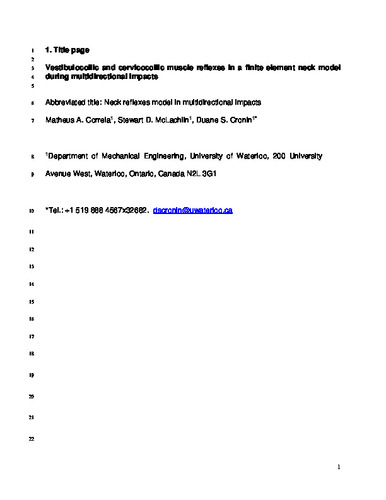| dc.contributor.author | Correia, Matheus | |
| dc.contributor.author | McLachlin, Stewart | |
| dc.contributor.author | Cronin, Duane | |
| dc.date.accessioned | 2024-02-22 20:44:54 (GMT) | |
| dc.date.available | 2024-02-22 20:44:54 (GMT) | |
| dc.date.issued | 2021-05-03 | |
| dc.identifier.uri | https://doi.org/10.1007/s10439-021-02783-2 | |
| dc.identifier.uri | http://hdl.handle.net/10012/20359 | |
| dc.description.abstract | Active neck musculature plays an important role in the response of the head and neck during impact and can affect the risk of injury. Finite element Human Body Models (HBM) have been proposed with open and closed-loop controllers for activation of muscle forces; however, controllers are often calibrated to specific experimental loading cases, without considering the intrinsic role of physiologic muscle reflex mechanisms under different loading conditions. This study aimed to develop a single closed-loop controller for neck muscle activation in a contemporary male HBM based on known reflex mechanisms and assess how this approach compared to current open-loop controllers across a range of impact directions and severities. Controller parameters were optimized using volunteer data and independently assessed across twelve impact conditions. The kinematics from the closed-loop controller simulations showed good average CORA rating to the experimental data (0.699) for the impacts following the ISO/TR9790 standard. Compared to previously optimized open-loop activation strategy, the average difference was less than 9%. The incorporation of the reflex mechanisms using a closed-loop controller can provide robust performance for a range of impact directions and severities, which is critical to improving HBM response under a larger spectrum of automotive impact simulations. | en |
| dc.language.iso | en | en |
| dc.publisher | Springer | en |
| dc.relation.ispartofseries | Annals of Biomedical Engineering;49(7) | |
| dc.rights | Attribution-NonCommercial-NoDerivatives 4.0 International | * |
| dc.rights.uri | http://creativecommons.org/licenses/by-nc-nd/4.0/ | * |
| dc.subject | impact mechanics | en |
| dc.subject | finite element analysis | en |
| dc.subject | muscle activation | en |
| dc.title | Vestibulocollic and Cervicocollic Muscle Reflexes in a Finite Element Neck Model During Multidirectional Impacts | en |
| dc.type | Preprint | en |
| dcterms.bibliographicCitation | Correia, M. A., McLachlin, S. D., & Cronin, D. S. (2021). Vestibulocollic and Cervicocollic muscle reflexes in a finite element neck model during multidirectional impacts. Annals of Biomedical Engineering, 49(7), 1645–1656. https://doi.org/10.1007/s10439-021-02783-2 | en |
| uws.contributor.affiliation1 | Faculty of Engineering | en |
| uws.contributor.affiliation2 | Mechanical and Mechatronics Engineering | en |
| uws.typeOfResource | Text | en |
| uws.peerReviewStatus | Unreviewed | en |
| uws.scholarLevel | Graduate | en |


